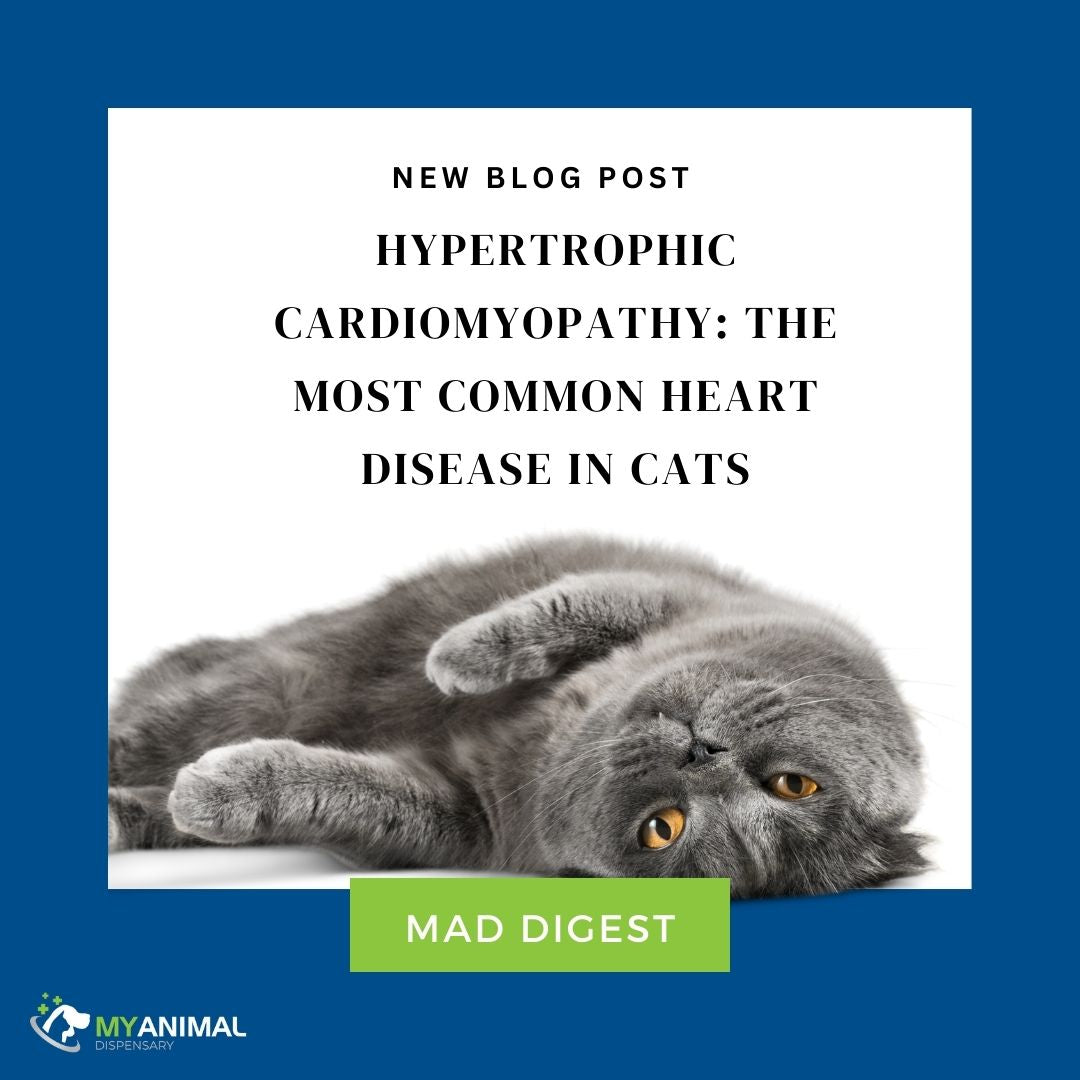
Hypertrophic Cardiomyopathy: The Most Common Heart Disease in Cats
Last month, we discussed mitral valve disease in dogs. Although our feline friends can be affected by heart disease as well, they are a little bit different, as they often like to be. Unlike in dogs (and humans), the most common heart disease of cats is hypertrophic cardiomyopathy (HCM), which affects the heart muscle. As always, to understand heart disease, one must start with an understanding of normal heart anatomy.
The heart pumps blood by alternately relaxing and contracting. It is divided into four chambers – two smaller atria and two larger ventricles.
When the heart is relaxed, the ventricles fill with blood from the atria. When the heart contracts, blood is pushed out of the ventricles.

Simplified diagram of a normal heart pumping blood. LA = left atrium, RA = right atrium, LV = left ventricle, RV = right ventricle. White arrows represent blood flow.
What is HCM?
HCM is a disease that causes the heart wall to thicken, most commonly affecting the left ventricle. This is not a good thing – the thickened muscle is stiff and has trouble stretching to accommodate blood. Therefore, when the heart relaxes, the left ventricle can’t completely fill with blood. Blood accumulates “upstream” in the left atrium and the vessels that supply it.

Simplified diagram of a relaxed heart with HCM. Because the left ventricle cannot accommodate as much blood, it backs up towards the lungs.
The disease has been linked to mutations in certain genes. Although any cat may develop HCM, breeds that are more prone include the Maine Coon, Ragdoll and Domestic Shorthair (short-haired cats with no identifiable breed).
What are symptoms of HCM?
HCM exists on a spectrum from mild to severe. The disease is progressive, and speed of progression varies greatly between cats. Fortunately, most affected cats have mild to moderate disease, meaning they show no signs and never progress to a stage where they become ill.
However, for those who progress to severe disease, the consequences can be devastating. Two common complications, which may occur separately or together, include heart failure and clot formation in blood vessels (“throwing clots”).
Unfortunately, cats are experts at hiding their symptoms until they become very severe, meaning cats with severe HCM often present as emergencies.
Heart failure
Heart failure occurs when too much blood accumulates “upstream” of the left ventricle, into the blood vessels of the lungs. Although the heart keeps beating, fluid builds up within the lungs, and sometimes also in the space surrounding the lungs, making breathing difficult.
Please seek immediate veterinary attention if your cat displays any of the signs highlighted in red.
• Lethargy
• Laboured and/or shallow breathing (with or without an open mouth)
• Blue-tinged tongue and/or gums
• Collapse
• In rare, extreme cases, affected cats may pass away suddenly with no prior symptoms.
Blood clot formation
Blood clot formation is encouraged by the backup of blood. Most commonly, a clot lodges in the blood vessel that supplies both hind legs, cutting off blood supply and causing severe pain. It’s possible, although rare, for only one hind leg to be affected, or for a front leg to be affected.
The following signs are all emergencies and should be assessed immediately by a veterinarian.
• Sudden collapse
• Dragging hind legs
• Yowling in pain
• Affected paws cool to the touch
• Pale or purplish pads on affected paws

Note the pale pads on this cat’s hind paw (bottom). On top is the cat’s unaffected front paw. Photo courtesy Vettimes.
How is HCM diagnosed?
Mild cases often picked up when your cat is well. As part of health screening, vets may run a blood test called NT-proBNP (a marker of heart function). Abnormal results increase suspicion for HCM, but do not confirm it.
Many severe cases of HCM are diagnosed on an emergency basis, when a vet suspects heart failure and/or blood clot formation.
• When listening to your cat’s chest, your vet may hear an abnormal heart rhythm and/or sound.
• Chest X-rays may reveal an enlarged heart, or fluid within or surrounding the lungs.
• As above, NT-proBNP may be abnormal.
None of these tests confirm HCM. In any case, an echocardiogram (specialised ultrasound scan of the heart) is required to confirm the diagnosis.
How is HCM treated?
With HCM, the changes to the heart cannot be slowed or reversed. Treatment focuses on reducing the risk of blood clot formation, often with medications such as clopidogrel.
Cats who present as an emergency may require hospitalisation before they are stable enough to continue treatment at home. Any fluid that has accumulated around the lungs will need to be drained. Furosemide and/or spironolactone are often also given to slow further fluid buildup within and around the lungs.
Your vet may also recommend:
• Regular rechecks
• Repeated drainage of fluid surrounding the lungs, as it will accumulate again over time
• Repeat echocardiograms
• Some form of at-home monitoring, such as counting the number of breaths your cat takes per minute while asleep
The long-term outlook
The outlook for cats with HCM is highly variable. Most cats with mild to moderate disease live out normal lives and never progress to heart failure.
Those who develop heart failure may do so over months to years. Once heart failure occurs, most cats live only several more months.
Sadly, cats who throw clots have a very poor outlook. Even with hospitalization, many pass away or are euthanised (“put to sleep”) within days of the event, and those who survive are at high risk of repeat episodes.
Thank you for reading and we hope the information in this article has been useful for you and your pet. Please consult your veterinarian if you have any specific queries about your pet’s health.



Leave a comment